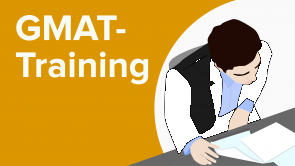(engl.) GMAT data sufficiency practice questions (Chapter 2, Part 3)

Über den Vortrag
Der Vortrag „(engl.) GMAT data sufficiency practice questions (Chapter 2, Part 3) “ von Robert Kuehl ist Bestandteil des Kurses „GMAT-Training“. Der Vortrag ist dabei in folgende Kapitel unterteilt:
- Introduction to data sufficiency
- How to solve data sufficiency
- Training the AD/BCE logic
- Data Sufficiency Question 1 (easy)
- Data Sufficiency Question 2 (easy)
- Data Sufficiency Question 3 (easy)
- Data Sufficiency Question 4 (easy)
- Data Sufficiency Question 5 (easy)
- Data Sufficiency Question 6 (medium)
- Data Sufficiency Question 7 (medium)
- Data Sufficiency Question 8 (medium)
- Data Sufficiency Question 9 (medium)
- Data Sufficiency Question 10 (medium)
- Data Sufficiency Question 11 (hard)
- Data Sufficiency Question 12 (hard)
- Data Sufficiency Question 13 (hard)
- Data Sufficiency Question 14 (hard)
- Data Sufficiency Question 15 (hard)
- Data Sufficiency Question 16 (hard)
Quiz zum Vortrag
What is the difference between a Data Sufficiency question and a Problem Solving question?
- Data Sufficiency questions always have 5 response options.
- Data Sufficiency questions are about finding a detail, which helps to solve the question.
- Data Sufficiency questions demand new solving techniques.
- Data Sufficiency questions are only about estimating the result.
If in a data sufficiency question the first statement is already sufficient to answer the question, then which answers are not possible?
- B, C and E
- A, D and E
- A and D
- C and E
What do you need to calculate the arithmetic mean?
- The sum
- The count of numbers
- The parameter
- The mean
How much is 15% out of 67?
- 10,05
- 10,5
- 10,25
- 10,02
What is the tens digit of 87?
- 8
- 7
- 1/8
- 0,87
- 8,7
Are 19$ more than 15% of 118$?
- Yes, 15% of 118$ are 17,7$.
- Yes, 15% of 118$ are 17,4$.
- No, 15% of 118$ are 20,5$.
- No, 15% of 118$ are 20,7$.
The x-th root of 4913 is 17. What is x?
- 3
- 2
- 4
- 5
The x-th root of 576 is 24. What is x?
- 2
- 3
- 4
- 5
How much is 27,5% out of 372?
- 102,3
- 102,32
- 102,2
- 102,23
How many minutes should you spend on one Data Sufficiency question?
- Less than 2 minutes
- 2-3 minutes
- 3-4 minutes
- 4-5 minutes
GMAT test takers rarely choose response option "E: Statements (1) and (2) TOGETHER are NOT sufficient." In how many Data Sufficiency questions is E the right answer?
- 1/5 of all Data Sufficiency questions
- 20% of all Data Sufficiency questions
- Half of all Data Sufficiency questions
- Only 5-10% of all Data Sufficiency questions
- 40% of all Data Sufficiency questions
Diese Kurse könnten Sie interessieren
Kundenrezensionen
4,0 von 5 Sternen
| 5 Sterne |
|
1 |
| 4 Sterne |
|
0 |
| 3 Sterne |
|
1 |
| 2 Sterne |
|
0 |
| 1 Stern |
|
0 |
2 Kundenrezensionen ohne Beschreibung
2 Rezensionen ohne Text
Auszüge aus dem Begleitmaterial
... the statements up. Always remember AD or BCE and use it this way on your scratch paper Examples: What is the Value of x? (1) y=4 (2) ?? Is Y an ...
... number of inhabitants as did Municipality B? (1) In 2012, Municipality A had 180.000 more inhabitants than did Municipality B. (2) In 2012, the 3,000 inhabitants of Municipality A, who have a registered pet made up 12.5% of that Municipality’s total number ...
... Statement ALONE answers the question (B) the second Statement ALONE answers the question (C). You need both statements TOGETHER to answer the question (D). Both statements SEPERATELY answer the question (E) ...
... answer the question (D). Both statements SEPERATELY answer the question (E). NEITHER statement separately or together answer the question DS3: What is the perimeter ...
... ALONE answers the question (B). the second Statement ALONE answers the question (C). You need both statements TOGETHER to answer the question (D). Both statements SEPERATELY answer the question (E). NEITHER statement separately ...
... statement separately or together answer the question DS5: Do more than 50% of the children in a certain nursery group have brown hair? 1) 70 % of the boy in the group ...
... Statement ALONE answers the question (B). the second Statement ALONE answers the question (C). You need both statements TOGETHER to answer the question (D). Both statements SEPERATELY answer the question (E) ...
... separately or together answer the question. If the variables a, b, c, d are =/= 0, in what quadrant of the coordinate system above does point (b, d) lie? (1) ...
... question (B). the second Statement ALONE answers the question (C). You need both statements TOGETHER to answer the question (D). Both statements SEPERATELY answer the question (E). NEITHER statement separately or together answer the question DS8: A certain ...
... $99, he calculates the tip as follows: 2 times the tens digit of the amount of his bill. If the amount of Daniel's recent restaurant bill was between $10 and $99, was the tip calculated by Daniel on this bill greater than 15% of ...
... the first Statement ALONE answers the question (B). the second Statement ALONE answers the question (C). You need both statements TOGETHER to answer the question (D). Both statements ...
... the question (D). Both statements SEPERATELY answer the question (E). NEITHER statement separately or together answer the question DS11: What is the value of integer ...
... Statement ALONE answers the question (B). the second Statement ALONE answers the question (C). You need both statements TOGETHER to answer the question (D). Both statements SEPERATELY answer the question (E). ...
... a petrol version. It sells this car in only two colors: red and blue. Last year, the dealership sold 900 vehicles, half of which were red. How many petrol cars did the dealership sell last year? (1) The dealership sold three times as many ...
... types of cars for their car park, either for $7,000 or for $10,000. The total amount of all cars bought was $2,300,000. Did the company bought more cars for $7,000 than cars for $10,000 during this one year period? (1) A total of 275 ...
... is 1/2. (2) The probability that the second sweet chosen will be a chocolate truffle is 4 / 9 GMAT Quant Data Sufficiency. Test Questions (A) the first Statement ALONE answers the question (B) the second Statement ALONE answers the ...
... numbers consists of 24 nonzero integers. If each number in this sequence is the product of the previous two numbers, how many numbers in this sequence are negative? (1) The third term in the ...



